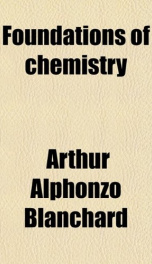teachers handbook to accompany foundations of chemistry

Purchase of this book includes free trial access to www.million-books.com where you can read more than a million books for free. This is an OCR edition with typos. Excerpt from book: just about as rapidly as it is produced, hence the heat within the body of wood cannot become much more intense than in the surroundings. 9. The material products of burning coal in a furnace are gases which pass up the chimney; smoke, which consists of solid particles and globules of tarry matter; and ashes, which consist of the incombustible residue from the coal. These products are of no use, and the ashes and smoke are difficult to dispose of without making a nuisance. Hence the furnace is surely not run to obtain these substances. 10. After a mason slakes lime, he allows the product to cool before he uses it mixed with sand and hair as mortar. In this reaction it is the material product and not the heat that is sought. CHAPTER II MIXTURES AND CHEMICAL SUBSTANCES Pages 15-19 To illustrate the separation of a mechanical mixture it may be well to have the pupils separate the constituents of black gunpowder, with which they are already familiar. To do this treat a pinch of powder with a few c.c. of carbon disulphide, filter into a watch glass, and allow the disulphide to evaporate. This will give sulphur by itself. Next use a few c.c. of water with the solid residue (first allow all the carbon disulphide to evaporate) and again filter on to a clean watch glass. On evaporating the water, they will now obtain saltpeter. The insoluble charcoal of the gunpowder will be left on the filter paper. As gunpowder is so excellently blended, few pupils would suspect at first that it is a mixture, and yet the simple physical means of separation above outlined will serve to show its character. Answers to Questions on Chapter II Page 19 1. Matter is that of which any physical object or body is composed, whatever its form or condition, whether gaseous like air, liquid ...
Info about the book
Series:
Unknown
ISBN:
0781793831
Rating:
5/5 (1)Your rating:
0/5
Languge:
English
Users who have this book
Users who want this book
What readers are saying
What do you think? Write your own comment on this book!
write a commentif you like teachers handbook to accompany foundations of chemistry try:
Do you want to read a book that interests you? It’s EASY!
Create an account and send a request for reading to other users on the Webpage of the book!



